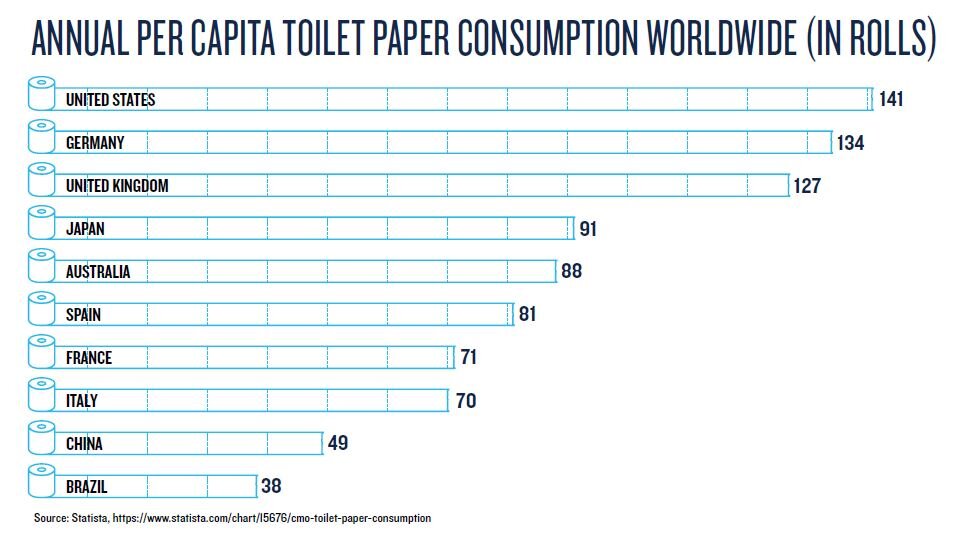Once I became truly aware of the issue in the US with garbage and the joke that recycling is in our country, I started researching and reading about how I could make some changes as a consumer to improve the situation. What difference could I make?
One of the most surprising things I learned was about American’s excessive use of paper products. The Natural Resources Defense Council (NRDC) is a 501(c)(3) non-profit that focuses on international environmental advocacy. Before believing what I was reading in the NRDC reports, I wanted to make sure it wasn’t an organization like the American Chemical Council. According to Charity Navigator, NRDC has a 4-star rating and scored 93.34 out of 100 – scoring higher than the American Heart Association or the American Red Cross. Based on this rating, I think NRDC is a reputable charity but in total transparency, The Wall Street Journal does call them the “most effective lobbying and litigating group on environmental issues” and have been listed as references in numerous NY Times articles as an expert on environmental issues.
The NRDC released a “Sustainability Scorecard” and report (31 page report) in early 2019 specific to tissue products and a number of the statistics were staggering.
The Cold Hard Facts
The US tissue market is worth $31 BILLION annually.
Americans (4% of the world’s population) are responsible for 20% of global consumption.
US tissue products come from the boreal forest in Canada. Loggings takes a million acres of this forest each year to meet US demand.
About the Boreal Forest:
Just below the Arctic Circle stretching across Alaska, Canada, Scandinavia, Russia, and China.
Acts as a storehouse for carbon which is vital to avoid the impacts of climate change and absorbs man-made greenhouse gas emissions.
“Clearcutting in the Canadian boreal releases, on average, 26 million metric tons of carbon dioxide each year, which is equivalent to 12% of the emissions Canada agreed to cut annually by 2030 under the Paris Agreement.” -NRCD Report
The Canadian boreal forest spans more than 1 billion acres, is home to more than 600 Indigenous communities and many species that are facing extinction.
Between 1996 – 2015, more than 28 million acres were logged by clearcutting which removes all trees and can take more than a century to return and leaves scaring in the landscape which can prevent trees from growing.
“We are quite literally flushing [forests] down the toilet.” -NRCD Report
Proctor & Gamble, Kimberly-Clark, and Georgia-Pacific still rely almost exclusively on the virgin pulp from trees. Charmin, Cottonelle, and Angel Soft are made entirely from this virgin fiber, which is the most environmentally destructive and the most common source of tissue pulp. This tissue pulp is made by milling logs into wood chips and sending the chips through a chemical process to remove the natural adhesives from the fiber which is then sent through a chemical bleaching process*.
“Creating products using 100% virgin fiber generates three times as much carbon as products made from other types of pulp.” -NRDC Report
Alternatives to Virgin Pulp Tissue Products
recycled content
wheat straw
bamboo
kenaf (similar to cotton)
This brought me to a search for a more environmentally friendly option for tissue and Who Gives A Crap was recommended so I gave them a try.
Who Gives A Crap was a crowdfunded endeavor in 2012 that raised $50,000 in 50 hours and their products are 100% made without trees. Rolls come shipped in a cardboard box (easy recycling) and individually wrapped with fun paper – not that plastic wrap that is not recyclable.
NOTE: Toilet paper snobs – this is not like Charmin or Cottonelle but it’s also not the cheap, 1-ply you get in most public bathrooms.
It is made with 100% recycled paper and is free of all inks, dyes, or scents. They also sell tissues (AKA Kleenex) and paper towels, which I haven’t tried yet but are on my list to try. Cost is comparable to most store brands, but is a little more expensive if you buy the industrial packages of tissue products at Sam’s or Costco.








